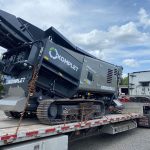Traditional methods of coastal erosion management often come with a hefty price tag and environmental concerns. But what if there was a way to combat erosion using recycled materials in a sustainable and cost-effective manner? This article will explore how C&D shredders emerge as game-changers in coastal protection.
Let’s begin!
Understanding Coastal Erosion: Causes and Challenges
By definition, coastal erosion is the process by which shorelines wear away. It results from both natural and man-made factors combined. It poses challenges such as loss of land, environmental and economic losses, etc. Read on to understand the concept further.
The Science Behind Coastal Erosion
Natural forces like waves, tides, and currents interact with shorelines to cause erosion. As climate change raises sea levels and alters weather patterns, waves continue to chip away at the shorelines. Tides move sediment around, and currents can either steal or deposit material.
Impact on Communities and Ecosystems
Coastal erosion can displace community residents, damage cultural sites, and disrupt local economies. It also impacts ecosystems by threatening sensitive habitats like dunes and wetlands and by endangering wildlife.
The Innovative Approach: Construction Shredders in Action
Construction demolition shredders provide a sustainable solution for mitigating erosion. Let’s take a deeper look.
From Debris to Defense: How Shredders Create Erosion Barriers
Construction debris shredders are used to create protective barriers from recycled debris. Concrete, asphalt, and bricks are collected and crushed into specific sizes, then strategically placed along the shoreline.
Processing Materials for Coastal Protection
You may be wondering, how do industrial shredders work? The collected debris is broken down into various-sized fragments and then transported to the designated location for barrier formation.
Types of Barriers and Their Effectiveness
The container system comprises prefabricated containers made of strong mesh or geotextile fabric. These containers are stacked or connected to form a cohesive barrier, which allows for easier future maintenance or removal if needed.
The second type of barrier, loose placement, involves directly dumping debris and shaping it into a desired slope. This method is quicker and less expensive, but it will require large quantities of material.
Case Studies: Successful Coastal Erosion Projects
In Thailand, coastal erosion threatened to damage the coastlines, so the authorities used a stepped concrete revetment. This solution dissipated wave energy and minimized overtapping.
Implementing Shredded Materials in Erosion Control
The revetment’s core structure consisted of precast or poured shredded concrete steps similar to the container system mentioned earlier. These steps absorbed the wave energy and dissipated its force.
Lessons Learned and Best Practices
Ensure the shredded material is designed and implemented in the best possible way. Step size, crest height, and the overall structure must be planned to ensure functionality and minimize overtapping. Regularly assess the barriers’ performance to ensure their long-term effectiveness.
Key Takeaways
Demolition shredders provide a sustainable and unique solution to coastal erosion. Shredding debris and forming it into different types of barriers is not only cost-effective but also environmentally friendly. Hence, if you are looking for a mobile construction debris shredder, feel free to visit our official website.








